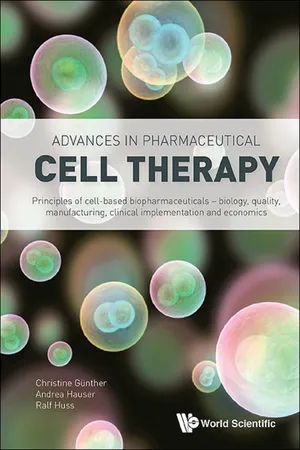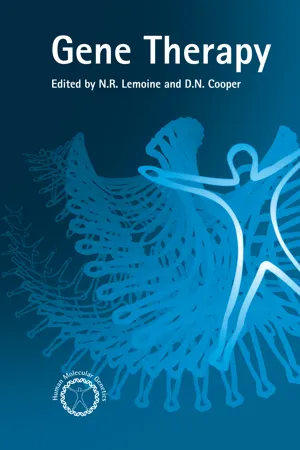Chemistry
Gene Therapy Process
Gene therapy is a process that involves introducing genetic material into a patient's cells to treat or prevent disease. This can be achieved by using viral vectors or other delivery methods to transfer the therapeutic genes into the target cells. The goal is to correct genetic mutations or provide new functions to the cells, offering potential treatments for various genetic disorders.
Written by Perlego with AI-assistance
Related key terms
5 Key excerpts on "Gene Therapy Process"
- eBook - ePub
Methods and Applications of Statistics in Clinical Trials, Volume 1
Concepts, Principles, Trials, and Designs
- N. Balakrishnan(Author)
- 2014(Publication Date)
- Wiley(Publisher)
Chapter 33 Gene Therapy Samantha L. Ginn and Ian E. Alexander 33.1 Introduction Gene therapy is defined by the United Kingdom’s Gene Therapy Advisory Committee as “the deliberate introduction of genetic material into human somatic cells for therapeutic, prophylactic or diagnostic purposes” [1] and was conceived, originally, as an approach for the treatment of inherited monogenic diseases. Ongoing improvements in gene-transfer technologies and biosafety have been accompanied by a growing appreciation of the broader scope of gene therapy. Pathophysiological processes such as wound healing [2, 3], chronic pain [4] and inflammation [5, 6], cancer [7–9], and acquired infections such as HIV-1 [10] are now becoming realistic targets for this promising therapeutic modality. The first authorised gene transfer study took place at the National Institutes of Health (NIH) in 1989. In this marker study, tumor-infiltrating lymphocytes were harvested, genetically tagged using a 7-retroviral vector, and reinfused with the intention of examining the tumor-homing capacity of these cells. This landmark study provided the first direct evidence that human cells could be genetically modified and returned to a patient without harm [11]. Since then, over 1800 trials have been approved, initiated, or completed worldwide [12], with the majority being in the United States [13, 14]. Most studies have focused on cancer, with monogenic and cardiovascular diseases the next most frequent indications (Table 1). These predominantly early-phase trials have provided invaluable proof-of-concept for gene therapy by confirming that desired changes to the target cell phenotype can be achieved successfully. In most trials, however, an insufficient number of cells have been genetically modified to achieve therapeutic benefit - eBook - ePub
Advances In Pharmaceutical Cell Therapy: Principles Of Cell-based Biopharmaceuticals
Principles of Cell-Based Biopharmaceuticals
- Christine Günther, Andrea Hauser, Ralf Huss(Authors)
- 2015(Publication Date)
- WSPC(Publisher)
Cell-Based Gene Therapy 14Sabine Geiger14.1Definition: What is Gene Therapy?
Gene therapy is the use of genetic material for therapeutic purposes. It is still mostly an investigational treatment that involves the introduction of recombinant nucleic acids into an individual’s cells to prevent, cure or alleviate disease. From the beginning, gene therapy had a rocky course, but due to breakthrough successes during the last few years, gene therapy is now on its way to progressing from an exploratory therapy to an approved treatment.Most commonly, DNA is introduced into cells or tissues by means of the so-called “vectors”. From the very early beginnings of gene therapy until now, the choice of vector was and still remains one of the most crucial points to consider when planning a gene therapy treatment. To date, viruses that are genetically modified to be safe for the patient are the most frequently used type of vector in gene therapy clinical trials worldwide. - eBook - ePub
Molecular Medicine
An Introduction
- Jens Kurreck, Cy Aaron Stein(Authors)
- 2015(Publication Date)
- Wiley-Blackwell(Publisher)
However, advances in vector technology are likely to overcome these obstacles in the near future. The term gene therapy refers to the transfer of genetic material into the cells of an individual's body with the intention of treating a disease. Classically, the affected patient carries a defective gene, the cause of the disease. The methods of molecular biology can be used to transfer the functional form of the gene to hopefully correct the defect (Figure 11.1). Examples of gene therapy include correction of metabolic functions, the replacement of missing blood coagulation factors, or the transfer of tumor suppressor genes for the treatment of cancer. In addition, gene therapy can be used to create cells with novel properties. For example, the body's own defense mechanisms against tumor cells can be triggered by the use of genes encoding cytokines. Genes for enzymes can be transferred, which convert the inactive precursor of a drug (prodrug) into the active form. DNA vaccination involves transferring viral genes, which trigger an immune response against the virus. Indeed, any transfer of nucleic acids designed to manipulate genes or to regulate gene expression may also be considered gene therapy. Examples also include antisense and RNA interference therapies, which will be addressed in Chapter 13. Fig. 11.1 Principles of gene therapy. Due to a defective gene, a protein may not be produced in the cells of the affected patient. With the aid of vectors, the intact version of the gene can be introduced into these cells. Whether or not the therapeutic gene is integrated into the genome of the host or remains episomal is determined by the choice of vector. The functional gene can then be expressed so that the active protein is synthesized and the defect corrected - eBook - ePub
- David Cooper, Prof Nick Lemoine, David Cooper, Prof Nick Lemoine(Authors)
- 2020(Publication Date)
- Garland Science(Publisher)
15Cancer gene therapy I: genetic intervention strategies
Lesley-Ann Martin and Nicholas R. Lemoine15.1 Introduction
The aim of current cancer treatments is to destroy as much of the malignancy as possible without damaging normal tissue. However, despite continuing advances in surgical techniques and improvements in radiotherapeutic and chemotherapeutic regimes, this often proves difficult when tumours are inaccessible or widely disseminated throughout the body (Sikora, 1993). The continuing characterization of genes contributing to the development of cancer presents an opportunity to utilize these genetic elements and their products as targets for the treatment and (in the long term) prevention of the disease. In this chapter, we review some of the gene therapy strategies that are being developed for the treatment of cancer together with a consideration of how genetic intervention could be used in the context of the hereditary predisposition syndromes.15.2 Somatic and germ-line therapy
Gene therapy can be defined as the introduction and expression of exogenous genetic material into human cells to provide therapeutic benefit (Lemoine, 1994). This can be achieved by correcting an existing abnormality or by providing the cells with a new function. At present, the permanent correction of an inherited genetic condition by gene transfer to germ cells cannot be contemplated (Gutierrez et al., 1992; Lemoine, 1994; Wivel and Walters, 1993).15.3 Prevention of hereditary predisposition syndromes
Prevention of cancer currently relies on epidemiological studies to identify factors involved in the aetiology of the disease and the subsequent modification of behavioural patterns of the general public. However, these studies require extensive research and the implementation of new health education measures, both of which can take decades to come to fruition (Gullick and Handyside, 1994). - P. Piguet, P. Poindron(Authors)
- 2012(Publication Date)
- S. Karger(Publisher)
Piguet P, Poindron P (eds): Genetically Modified Organisms and Genetic Engineering in Research and Therapy. BioValley Monogr. Basel, Karger, 2012, vol 3, pp 86–102 ______________________ Gene Therapy for Cancer Treatment – State of the Art Amor Hajri Institute of Biology III, University of Freiburg, Freiburg, Germany ______________________ Abstract During the last decades, significant advances have been made in the field of gene therapy for the identification of new therapeutic genes, the design of innovative vectors and different ways of targeting. Cancer gene therapy is not indicated in clinical practice yet. However, basic and clinical advances have been reported which indicate the swift evolution of this field which, without any doubt, will be part of future cancer therapies. Many of the past obstacles and barriers are being actively overcome now. We are hopeful that cancer gene therapy will continue to progress and ultimately take its place within the existing anticancer armamentarium. Copyright © 2012 S. Karger AG, Basel Advances in molecular medicine as well as completion of the human genome project have allowed the identification of numerous disease-causing genes. These led to a new therapeutic approach, i.e. gene therapy that uses genes as a medicine to treat, cure or even prevent disease and thereby improve the quality of life. Gene therapy includes the treatment of both genetically based and infectious diseases by introducing genetic materials which have therapeutic effects [ 1 - 3 ]. It was first conceived as a treatment for hereditary single-gene defects, but gene replacement or repair can bring permanent relief in a number of other disorders. Therefore, gene therapy is also being developed for (1) acquired diseases such as cancer, (2) cardiovascular diseases, or (3) neurodegenerative disorders including Alzheimer’s, Parkinson’s and Huntington’s diseases, and (4) infectious diseases
Learn about this page
Index pages curate the most relevant extracts from our library of academic textbooks. They’ve been created using an in-house natural language model (NLM), each adding context and meaning to key research topics.




